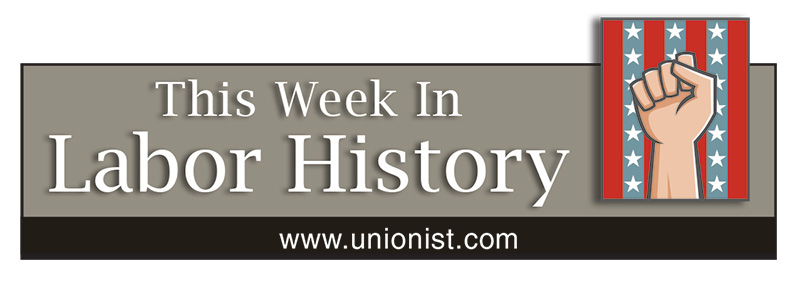This week in labor history: October 21-27

OCTOBER 21
1933 – Wisconsin dairy farmers begin their third strike of the year in an attempt to raise the price of milk paid to producers during the Great Depression. Several creameries were bombed before the strike ended a month later. The economy eventually improved, allowing the farmers to make more money.
OCTOBER 22
1934 – Bank robber Charles Arthur “Pretty Boy” Floyd is killed by FBI agents near East Liverpool, Ohio. He was a hero to the people of Oklahoma who saw him as a “Sagebrush Robin Hood,” stealing from banks and sharing some of the proceeds with the poor.
OCTOBER 23
1902 – President Theodore Roosevelt establishes a fact-finding commission that suspends a nine-months-long strike by Western Pennsylvania coal miners fighting for better pay, shorter workdays and union recognition. The strikers ended up winning more pay for fewer hours, but failed to get union recognition. It was the first time that the federal government had intervened as a neutral arbitrator in a labor dispute.
1989 – Explosion and fire at Phillips Petroleum refinery in Pasadena, Texas, kills 23 and injures 314.
2001 – Postal workers Joseph Curseen and Thomas Morris die nearly a month after having inhaled anthrax at the Brentwood mail sorting center in Washington, D.C. Other postal workers had been made ill but survived. Letters containing the deadly spores had been addressed to U.S. Senate offices and media outlets.
OCTOBER 24
1940 – The 40-hour work week goes into effect under the Fair Labor Standards Act, signed by President Roosevelt two years earlier.
OCTOBER 25
1899 – What many believe to be the first formal training on first aid in American history took place at the Windsor Hotel in Jermyn, Penn., when Dr. Matthew J. Shields instructed 25 coal miners on ways to help their fellow miners. Upon completion of the course each of the miners was prepared and able to render first aid. The training led to marked decreases in serious mining injuries and fatalities.
1934 – Some 25,000 silk dye workers strike in Paterson, N.J.
1949 – In what becomes known as the Great Hawaiian Dock Strike, a six-month struggle to win wage parity with mainland dock workers, ends in victory.
1990 – The Tribune Co. begins a brutal five-month-long lockout at the New York Daily News, part of an effort to bust the newspaper’s unions.
1995 – John Sweeney, president of the Service Employees Int’l Union, elected president of AFL-CIO.
2011 – After a two-year fight, workers at the Bonus Car Wash in Santa Monica, Calif., win a union contract calling for pay increases, better breaks and other gains. “They didn’t treat us like people,” nine-year employee Oliverio Gomez told the Los Angeles Times.
OCTOBER 26
1825 – After eight years and at least 1,000 worker deaths — mostly Irish immigrants — the 350-mile Erie Canal opens, linking the Great Lakes and the Atlantic Ocean. Father John Raho wrote to his bishop that “so many die that there is hardly any time to give Extreme Unction (last rites) to everybody. We run night and day to assist the sick.”
OCTOBER 27
1904 – The New York City subway, the first rapid-transit system in America, opens. More than 100 workers died during the construction of the first 13 miles of tunnels and track.
1935 – Three strikes on works-relief projects in Maryland were underway on this day, with charges that Depression-era Works Projects Administration jobs were paying only about 28 cents an hour — far less than was possible on direct relief. Civic officials in Cumberland, where authorities had established a 50-cent-per-hour minimum wage, supported the strikers.
1951 – The National Labor Council is formed in Cincinnati to unite black workers in the struggle for full economic, political and social equality. The group was to function for five years before disbanding, having forced many AFL and CIO unions to adopt non-discrimination policies.
(Labor History is provided by Union Communications Services, since 1981 North America’s premier publisher and distributor of newsletters, leadership training programs for shop stewards and officers, website materials and other powerful use-it-today strategies and tools to help leaders and activists build union power. Reach them at unionist.com.)


Leave a Reply